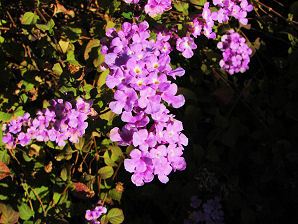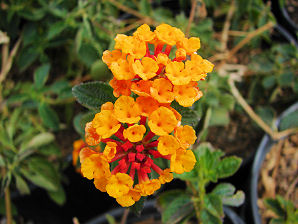Xeriscape Landscaping Plants For The Arizona Desert Environment.
Pictures, Photos, Information, Descriptions,
Images, & Reviews.
Groundcovers.
Trailing Lantana, Lantana montevidensis.
We Are Proud Of Our SafeSurf Rating!
Click On Any Of The Following Links By Amazon.Com
For Books, & Videos About Wildflowers Of Arizona & The Southwest USA. No Obligation!
 |
| Trailing Lantana, Lantana montevidensis. |
|---|
 |  |
| Trailing Lantana. Lantana montevidensis. | Trailing Lantana. Lantana montevidensis. |
|---|---|
 |  |
| Trailing Lantana. Lantana montevidensis. | Trailing Lantana. Lantana montevidensis. |
Trailing Lantana.
We wish to thank Wikipedia, the free encyclopedia for some of the information on this page. We share images and information with Wikipedia. There are over 100 subspecies of Lantana. Trailing Lantana has become a most popular landscaping plant in Arizona. During cold weather Lantana will appear not to be growing but will come back in warm weather. In general all Lantana's are extremely easy to grow requiring little attention and they are seldom bothered by pests or disease. They has low water requirements and can be used in xeriscapes and can handle the heat growing in containers and hanging baskets under sunny conditions. Lantana is a favorite species for butterflies and non-invasive lantanas should be a part of any butterfly garden. However, it is considered among the world's worst 100 Invasive Species. It naturally occurs in agricultural areas, coastland, disturbed areas, natural forest, planted forests, range/grasslands, riparian zones, scrub/shrublands, urban areas, wetlands It causes decreased productivity in pastures and it poisons cattle. It also invades disturbed natural ecosystems. Well drained soil is preferred by this plant. Lantana is very drought resistant. This tropical plant is killed back to the ground at 28 �F but will grow back from the roots when warm weather returns. However, it is an ideal Xeriscape Landscape Plant in Arizona.
Quick Notes:
Height: Evergreen bush slowly growing to about 28 inches tall and 10 feet wide. Most from the nursary are about 8 inches to 10 inches in height.
Flowers: The lavender, white, yellow, or gold small flowers are held in clusters (called umbels) that are typically 1 - 2 inches across.
Flowering Time: Early February - December.
Leaves: Leaves are covered with rough hairs and emit an unpleasant aroma when crushed. They are simple, ovate or ovate-oblong, acute or subacute, crenate-serrate, rugose above, scabrid on both sides.
Stalk: Woody when old, the sprawling stems are covered with rough hairs and emit an unpleasant aroma when crushed.
Found: Native to South America (i.e. Bolivia, Uruguay, Paraguay, Argentina and southern Brazil). The USDA claims it is now native to the USA (AL, CA, FL, GA, HI, LA, TX), USA+ (PR, VI). We see it throughout lower elevations in Arizona. It is considered invasive in Australia.
Hardiness: Some have reported it growing in Zona 8a in Arizona.
Soil pH requirements:
Sun Exposure:
Elevation: 0 to 4,500 feet In Arizona.
Habitat: Largely found in tropical and sub-tropical environments, and occasionally also in temperate and semi-arid regions. Primarily a weed of pastures, open woodlands, hillsides, railways, roadsides, embankments, disturbed sites and waste areas. In the USA it is below 4,500 foot elevations in chaparral and woodland communities.
Miscellaneous: Flowering Photos Taken February 23, 2006 and March 2, 2006. Arrowhead Ranch, Glendale, Arizona. An ideal xeriscape landscape plant in Arizona.
|
We Are Proud Of Our SafeSurf Rating!
Click On Any Of The Following Links By Amazon.Com
For Books, & Videos About Wildflowers Of Arizona & The Southwest USA. No Obligation!
| © 1966 - Present, Audrey, Eve, & George DeLange |
